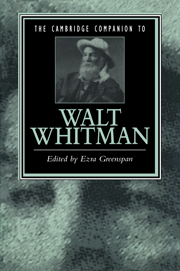Book contents
- Frontmatter
- 1 Introduction
- 2 “As If I Were With You”
- 3 Fratricide and Brotherly Love
- 4 Reading Whitman’s Postwar Poetry
- 5 Politics and Poetry
- 6 Some Remarks on the Poetics of “Participle-Loving Whitman”
- 7 “Being a Woman ... I Wish to Give My Own View”
- 8 Appearing in Print
- 9 “I Sing the Body Electric”
- 10 Walt Whitman
- 11 Borge's "Song of Myself"
- Suggestions for further reading
- Index
- Series List
9 - “I Sing the Body Electric”
Isadora Duncan, Whitman, and the Dance
Published online by Cambridge University Press: 28 May 2006
- Frontmatter
- 1 Introduction
- 2 “As If I Were With You”
- 3 Fratricide and Brotherly Love
- 4 Reading Whitman’s Postwar Poetry
- 5 Politics and Poetry
- 6 Some Remarks on the Poetics of “Participle-Loving Whitman”
- 7 “Being a Woman ... I Wish to Give My Own View”
- 8 Appearing in Print
- 9 “I Sing the Body Electric”
- 10 Walt Whitman
- 11 Borge's "Song of Myself"
- Suggestions for further reading
- Index
- Series List
Summary
Only months before she died in a freak automobile accident in Nice, France, in 1927, strangled by the same scarf with which she danced the impassioned Marseillaise, Isadora Duncan completed her autobiography, My Life. Twenty-five years after catapulting to international acclaim as the “barefoot dancer” from California, Duncan proclaimed the poet Walt Whitman one of her three “dance masters.” With the bravado typical of her after-concert lectures, she hailed Whitman as the “supreme poet of our country”and credited his poetry with having instilled in her “my great spiritual realization of life” (Duncan, My Life, 31, 341). To many of those who had followed the progress of her dance across three continents and nearly as many decades, Duncan's disclosure only confirmed what they had long since determined for themselves. Writer and editor Max Eastman was among those who perceived in Duncan's dance a strong Whitmanic presence. In his memoirs, Eastman extolled “that warm witty magnetism” with which she danced, terming her “not only a supreme artist. . . [but] also a creative and a moral force.” For him as for others of his generation, “[s]he really became, as she thought to, a winged apostle to the whole world of Walt Whitman's vision of a poised and free-bodied and free-souled humanity, carrying his thought to hearts that never heard of him.”
- Type
- Chapter
- Information
- The Cambridge Companion to Walt Whitman , pp. 166 - 193Publisher: Cambridge University PressPrint publication year: 1995
- 1
- Cited by

